Rolling bearing for rocker arm
a technology for rolling bearings and rockers, which is applied in the direction of mechanical control devices, process and machine control, instruments, etc., can solve the problems of inability to smoothly control roller positions, insufficient lubricating conditions, and high labor intensity, and achieve excellent anti-secular-dimensional-change, excellent anti-crack strength, and remarkable improvement of rolling fatigue li
- Summary
- Abstract
- Description
- Claims
- Application Information
AI Technical Summary
Benefits of technology
Problems solved by technology
Method used
Image
Examples
first embodiment
[0152]FIG. 1 is a schematic front view showing a rolling bearing for a rocker arm in use, according to a first embodiment of the present invention. FIG. 2 is a cross-sectional view along a line II-II in FIG. 1. Referring to FIGS. 1 and 2, rocker arm 1 that is a pivot member is pivotably supported, at a central portion located between one end 1a and the other end 1b, on a rocker arm shaft 5 via a bearing metal for example. Rocker arm 1 swings about rocker arm shaft 5.
[0153]Rocker arm 1 has one end 1b into which an adjust screw 7 is screwed. Adjust screw 7 is fastened by a lock nut 8 and has its lower end that abuts on an upper end 9a of an intake valve or exhaust valve of an internal combustion engine (open / close valve of an engine) 9. Valve 9 is biased by an elastic force of a spring 10.
[0154]Rocker arm 1 has the other end 1a where a bifurcated inner-ring support portion (outer-ring support portion) 14 is integrated. In an outer-ring shaft hole opened in this bifurcated inner-ring s...
second embodiment
[0171]Referring to FIGS. 1 to 5, inner ring 2 of rocker arm rolling bearing 50 in the present embodiment is made of a steel containing at least 0.50% by mass of carbon, has a hollow cylindrical shape and has a hardness of at least HV 200 and at most HV 300 at its end surface. Further, inner ring 2 of each rolling bearing 50 has, as shown in FIGS. 11(a), (b), a hardened layer extending entirely in the radial direction from a rolling surface of inner ring 2 where rollers (rolling elements) 3 roll to an inner circumferential surface 2c. Preferably, such a hardened layer is formed entirely in the circumferential direction of inner ring 2.
[0172]As a pattern of this hardened layer, Japanese Patent Laying-Open No. 2000-38906 discloses the one as shown in FIG. 10. Only a surface layer portion of the rolling surface of an outer circumferential surface 2b of inner ring 2 is a hardened layer 2a, and a surface layer portion of inner circumferential surface 2c and a surface layer portion of an e...
example 1
[0197]JIS standard SUJ2 was used to produce a rolling bearing for a rocker arm for use in a rolling fatigue test. The bearing was a full-type needle bearing used for a rocker arm. An inner ring had the size: outer diameter φ 14.64 mm×width L 17.3 mm, and an outer ring had the size: inner diameter φ 18.64 mm×outer diameter φ 24 mm×width L 6.9 mm. A roller had the size: outer diameter φ 2 mm×length L 6.8 mm, and 26 rollers were used. Further, the bearing had the structure of a full type rolling bearing without cage. The bearing had a basic dynamic load rating of 8.6 kN and a basic static load rating of 12.9 kN.
[0198]Test bearings were each produced through the following history.
[0199]Test bearings No. 1 to No. 3 (examples of the present invention): Carbonitriding was performed under the conditions of a carbonitriding temperature of 850° C. and hold time of 150 minutes. During the carbonitriding process, the ambient was a gas mixture of RX gas and ammonia gas. Here, for test bearings N...
PUM
| Property | Measurement | Unit |
|---|---|---|
| crystal grain size number | aaaaa | aaaaa |
| surface roughness | aaaaa | aaaaa |
| surface roughness | aaaaa | aaaaa |
Abstract
Description
Claims
Application Information
 Login to View More
Login to View More - R&D
- Intellectual Property
- Life Sciences
- Materials
- Tech Scout
- Unparalleled Data Quality
- Higher Quality Content
- 60% Fewer Hallucinations
Browse by: Latest US Patents, China's latest patents, Technical Efficacy Thesaurus, Application Domain, Technology Topic, Popular Technical Reports.
© 2025 PatSnap. All rights reserved.Legal|Privacy policy|Modern Slavery Act Transparency Statement|Sitemap|About US| Contact US: help@patsnap.com



